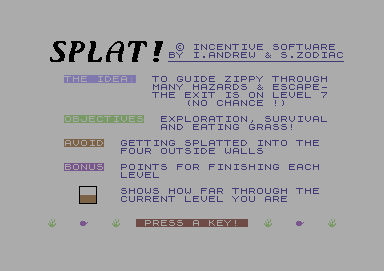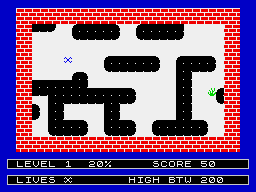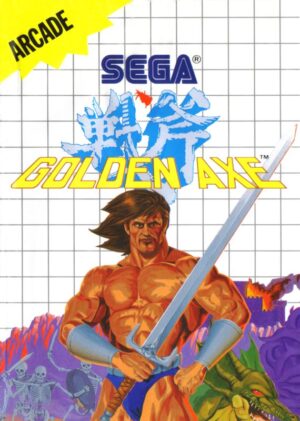Retro Replay Review
Gameplay
Splat! delivers a deceptively simple premise: guide a hungry spider through a winding maze and devour every patch of grass. On paper, this sounds like a straightforward dot-collection puzzle, but the real challenge comes from the ever-shifting screen. As you nip at each blade of green, the playfield scrolls randomly in one of four directions, making every movement feel like a delicate negotiation between progress and peril.
(HEY YOU!! We hope you enjoy! We try not to run ads. So basically, this is a very expensive hobby running this site. Please consider joining us for updates, forums, and more. Network w/ us to make some cash or friends while retro gaming, and you can win some free retro games for posting. Okay, carry on 👍)
The core tension arises when you realize that the maze walls are not merely obstacles but executioners—any contact with the screen edge, where the invisible wall lies in wait, costs you a precious life. This forces players to pause and plan routes, especially in tighter corridors or dead-end areas. It’s a brilliant twist on classic arcade mechanics, rewarding foresight and punishing hasty decisions.
With seven levels that grow progressively tougher, Splat! hooks you early with its quick, arcade-style sessions. Each stage introduces new wall patterns, more winding pathways, and strategic choke points. As you master one maze, you’ll quickly find that the next one demands even tighter control and faster reflexes.
The controls feel responsive, allowing for precise micro-adjustments when the screen scrolls unexpectedly. A moment’s hesitation can send your spider spiraling into a trap, but mastering the timing of each move—especially in high-stakes, frantic sequences—provides a genuine sense of accomplishment. For players who love puzzle-arcade hybrids, the tension-and-release loop here is exceptionally well tuned.
Graphics
Visually, Splat! opts for a clean, retro-inspired aesthetic that complements its arcade roots. The spider avatar is charmingly minimalistic, while the grass patches stand out in contrasting greens that make it easy to track remaining objectives. This clarity is crucial when split-second decisions matter.
The background maze walls shift through a palette of soft earth tones and subtle textures, ensuring that you’re never distracted by overly flashy effects. Each level’s unique wall pattern feels fresh, helping you memorize routes and anticipate tricky zones. The random scroll animations are smooth, preventing motion judder so you can focus on strategic planning rather than fight graphical hiccups.
Particle effects are kept to a minimum, but when your spider chomps a grass patch, a satisfying “pop” animation underscores the reward. These small touches lend character without overwhelming the screen. The UI overlays—life counters, level indicators—are discreet, leaving the maze as the unchallenged star of the show.
While Splat! doesn’t aim for hyper-realism or cutting-edge shaders, its purposeful design ensures gameplay readability. Whether you play on a small handheld device or a larger display, the crisp pixel art and clear iconography remain consistently legible, making long puzzle sessions a visual pleasure rather than a strain.
Story
Splat!’s narrative is minimalist by design, focusing more on mechanics than on a sprawling plot. Yet, there’s a subtle charm in framing your mission as a spider’s quest to reclaim its grassy domain. Each level can feel like a new “territory” to be cleaned and conquered, providing an implicit goal beyond simply clearing tiles.
This bare-bones storyline leaves room for players to project their own motivations. You might imagine your spider as a garden sentinel gobbling away invasive grass or a clever arachnid evading predators by darting through hidden tunnels. The lack of exposition supports a pure, pick-up-and-play experience without narrative distractions.
Occasional screen intros hint at deeper world-building—perhaps this spider is part of a bigger ecosystem or racing against time to restore order. While these touches are sparse, they serve to frame each successive level as part of a larger journey, rather than isolated puzzles.
For buyers seeking a narrative-driven adventure, Splat! won’t deliver character arcs or emotional plot twists. Instead, it offers an open canvas: the story is what you make of it, centered entirely around the thrill of carefully plotted movements and the satisfaction of a fully devoured maze.
Overall Experience
Splat! strikes a rare balance between accessibility and depth. Newcomers can latch on to the basic “eat grass and avoid walls” loop within seconds, while seasoned puzzle enthusiasts will find the random scrolling mechanic a refreshing challenge. The seven escalating levels provide just the right amount of content for quick sessions, yet they leave room for replay as you refine your strategies.
Longevity comes from perfecting each level’s optimal route. As you learn to anticipate screen shifts and master precise timing, you’ll discover subtle shortcuts and risk-reward gambits that keep the gameplay engaging. High-score chasers and completionists will relish the chance to clear each level flawlessly without losing a single life.
If there’s a drawback, it’s that some players might crave additional modes—time trials, endless surges, or multiplayer arenas—to extend replay. Still, Splat!’s core puzzle design is so compelling that its existing package feels satisfying for solo play, especially in short bursts during commutes or quick breaks.
Ultimately, Splat! is a delightful mix of classic arcade pressure and cerebral puzzle thinking. Its straightforward premise is enriched by unpredictable screen movement, forcing players to adapt and plan on the fly. For anyone looking for a bite-sized challenge with surprising depth, guiding that crafty spider through its grassy labyrinth is time—and lives—well spent.
 Retro Replay Retro Replay gaming reviews, news, emulation, geek stuff and more!
Retro Replay Retro Replay gaming reviews, news, emulation, geek stuff and more!









Reviews
There are no reviews yet.